9.1: Chapter 19- Physical Development in Adolescence
- Page ID
- 55308
\( \newcommand{\vecs}[1]{\overset { \scriptstyle \rightharpoonup} {\mathbf{#1}} } \)
\( \newcommand{\vecd}[1]{\overset{-\!-\!\rightharpoonup}{\vphantom{a}\smash {#1}}} \)
\( \newcommand{\id}{\mathrm{id}}\) \( \newcommand{\Span}{\mathrm{span}}\)
( \newcommand{\kernel}{\mathrm{null}\,}\) \( \newcommand{\range}{\mathrm{range}\,}\)
\( \newcommand{\RealPart}{\mathrm{Re}}\) \( \newcommand{\ImaginaryPart}{\mathrm{Im}}\)
\( \newcommand{\Argument}{\mathrm{Arg}}\) \( \newcommand{\norm}[1]{\| #1 \|}\)
\( \newcommand{\inner}[2]{\langle #1, #2 \rangle}\)
\( \newcommand{\Span}{\mathrm{span}}\)
\( \newcommand{\id}{\mathrm{id}}\)
\( \newcommand{\Span}{\mathrm{span}}\)
\( \newcommand{\kernel}{\mathrm{null}\,}\)
\( \newcommand{\range}{\mathrm{range}\,}\)
\( \newcommand{\RealPart}{\mathrm{Re}}\)
\( \newcommand{\ImaginaryPart}{\mathrm{Im}}\)
\( \newcommand{\Argument}{\mathrm{Arg}}\)
\( \newcommand{\norm}[1]{\| #1 \|}\)
\( \newcommand{\inner}[2]{\langle #1, #2 \rangle}\)
\( \newcommand{\Span}{\mathrm{span}}\) \( \newcommand{\AA}{\unicode[.8,0]{x212B}}\)
\( \newcommand{\vectorA}[1]{\vec{#1}} % arrow\)
\( \newcommand{\vectorAt}[1]{\vec{\text{#1}}} % arrow\)
\( \newcommand{\vectorB}[1]{\overset { \scriptstyle \rightharpoonup} {\mathbf{#1}} } \)
\( \newcommand{\vectorC}[1]{\textbf{#1}} \)
\( \newcommand{\vectorD}[1]{\overrightarrow{#1}} \)
\( \newcommand{\vectorDt}[1]{\overrightarrow{\text{#1}}} \)
\( \newcommand{\vectE}[1]{\overset{-\!-\!\rightharpoonup}{\vphantom{a}\smash{\mathbf {#1}}}} \)
\( \newcommand{\vecs}[1]{\overset { \scriptstyle \rightharpoonup} {\mathbf{#1}} } \)
\( \newcommand{\vecd}[1]{\overset{-\!-\!\rightharpoonup}{\vphantom{a}\smash {#1}}} \)
\(\newcommand{\avec}{\mathbf a}\) \(\newcommand{\bvec}{\mathbf b}\) \(\newcommand{\cvec}{\mathbf c}\) \(\newcommand{\dvec}{\mathbf d}\) \(\newcommand{\dtil}{\widetilde{\mathbf d}}\) \(\newcommand{\evec}{\mathbf e}\) \(\newcommand{\fvec}{\mathbf f}\) \(\newcommand{\nvec}{\mathbf n}\) \(\newcommand{\pvec}{\mathbf p}\) \(\newcommand{\qvec}{\mathbf q}\) \(\newcommand{\svec}{\mathbf s}\) \(\newcommand{\tvec}{\mathbf t}\) \(\newcommand{\uvec}{\mathbf u}\) \(\newcommand{\vvec}{\mathbf v}\) \(\newcommand{\wvec}{\mathbf w}\) \(\newcommand{\xvec}{\mathbf x}\) \(\newcommand{\yvec}{\mathbf y}\) \(\newcommand{\zvec}{\mathbf z}\) \(\newcommand{\rvec}{\mathbf r}\) \(\newcommand{\mvec}{\mathbf m}\) \(\newcommand{\zerovec}{\mathbf 0}\) \(\newcommand{\onevec}{\mathbf 1}\) \(\newcommand{\real}{\mathbb R}\) \(\newcommand{\twovec}[2]{\left[\begin{array}{r}#1 \\ #2 \end{array}\right]}\) \(\newcommand{\ctwovec}[2]{\left[\begin{array}{c}#1 \\ #2 \end{array}\right]}\) \(\newcommand{\threevec}[3]{\left[\begin{array}{r}#1 \\ #2 \\ #3 \end{array}\right]}\) \(\newcommand{\cthreevec}[3]{\left[\begin{array}{c}#1 \\ #2 \\ #3 \end{array}\right]}\) \(\newcommand{\fourvec}[4]{\left[\begin{array}{r}#1 \\ #2 \\ #3 \\ #4 \end{array}\right]}\) \(\newcommand{\cfourvec}[4]{\left[\begin{array}{c}#1 \\ #2 \\ #3 \\ #4 \end{array}\right]}\) \(\newcommand{\fivevec}[5]{\left[\begin{array}{r}#1 \\ #2 \\ #3 \\ #4 \\ #5 \\ \end{array}\right]}\) \(\newcommand{\cfivevec}[5]{\left[\begin{array}{c}#1 \\ #2 \\ #3 \\ #4 \\ #5 \\ \end{array}\right]}\) \(\newcommand{\mattwo}[4]{\left[\begin{array}{rr}#1 \amp #2 \\ #3 \amp #4 \\ \end{array}\right]}\) \(\newcommand{\laspan}[1]{\text{Span}\{#1\}}\) \(\newcommand{\bcal}{\cal B}\) \(\newcommand{\ccal}{\cal C}\) \(\newcommand{\scal}{\cal S}\) \(\newcommand{\wcal}{\cal W}\) \(\newcommand{\ecal}{\cal E}\) \(\newcommand{\coords}[2]{\left\{#1\right\}_{#2}}\) \(\newcommand{\gray}[1]{\color{gray}{#1}}\) \(\newcommand{\lgray}[1]{\color{lightgray}{#1}}\) \(\newcommand{\rank}{\operatorname{rank}}\) \(\newcommand{\row}{\text{Row}}\) \(\newcommand{\col}{\text{Col}}\) \(\renewcommand{\row}{\text{Row}}\) \(\newcommand{\nul}{\text{Nul}}\) \(\newcommand{\var}{\text{Var}}\) \(\newcommand{\corr}{\text{corr}}\) \(\newcommand{\len}[1]{\left|#1\right|}\) \(\newcommand{\bbar}{\overline{\bvec}}\) \(\newcommand{\bhat}{\widehat{\bvec}}\) \(\newcommand{\bperp}{\bvec^\perp}\) \(\newcommand{\xhat}{\widehat{\xvec}}\) \(\newcommand{\vhat}{\widehat{\vvec}}\) \(\newcommand{\uhat}{\widehat{\uvec}}\) \(\newcommand{\what}{\widehat{\wvec}}\) \(\newcommand{\Sighat}{\widehat{\Sigma}}\) \(\newcommand{\lt}{<}\) \(\newcommand{\gt}{>}\) \(\newcommand{\amp}{&}\) \(\definecolor{fillinmathshade}{gray}{0.9}\)Chapter 19 Learning Objectives
- Summarize the overall physical growth
- Describe the changes that occur during puberty
- Describe the changes in brain maturation
- Describe the changes in sleep
- Describe gender intensification
- Identify nutritional concerns
- Describe eating disorders
- Explain the prevalence, risk factors, and consequences of adolescent pregnancy
Growth in Adolescence
Sexual Development
Male Anatomy: Males have both internal and external genitalia that are responsible for procreation and sexual intercourse. Males produce their sperm on a cycle, and unlike the female’s ovulation cycle, the male sperm production cycle is constantly producing millions of sperm daily. The main male sex organs are the penis and the testicles, the latter of which produce semen and sperm. The semen and sperm, as a result of sexual intercourse, can fertilize an ovum in the female’s body; the fertilized ovum (zygote) develops into a fetus which is later born as a child.
Figure 6.1
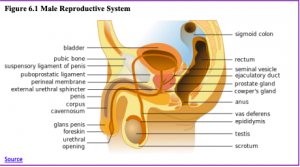
Figure 6.2
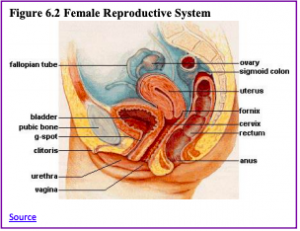
Female Anatomy: Female external genitalia is collectively known as the vulva, which includes the mons veneris, labia majora, labia minora, clitoris, vaginal opening, and urethral opening. Female internal reproductive organs consist of the vagina, uterus, fallopian tubes, and ovaries. The uterus hosts the developing fetus, produces vaginal and uterine secretions, and passes the male’s sperm through to the fallopian tubes while the ovaries release the eggs. A female is born with all her eggs already produced. The vagina is attached to the uterus through the cervix, while the uterus is attached to the ovaries via the fallopian tubes. Females have a monthly reproductive cycle; at certain intervals the ovaries release an egg, which passes through the fallopian tube into the uterus. If, in this transit, it meets with sperm, the sperm might penetrate and merge with the egg, fertilizing it. If not fertilized, the egg is flushed out of the system through menstruation.
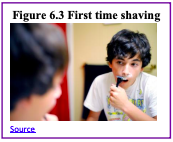

Gender Role Intensification: At about the same time that puberty accentuates gender, role differences also accentuate for at least some teenagers. Some girls who excelled at math or science in elementary school, may curb their enthusiasm and displays of success at these subjects for fear of limiting their popularity or attractiveness as girls (Taylor, Gilligan, & Sullivan, 1995; Sadker, 2004). Some boys who were not especially interested in sports previously may begin dedicating themselves to athletics to affirm their masculinity in the eyes of others. Some boys and girls who once worked together successfully on class projects may no longer feel comfortable doing so, or alternatively may now seek to be working partners, but for social rather than academic reasons. Such changes do not affect all youngsters equally, nor affect any one youngster equally on all occasions. An individual may act like a young adult on one day, but more like a child the next.

Adolescent Brain
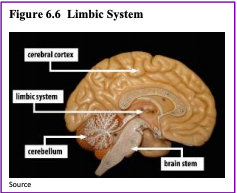
Adolescent Sleep
Why do adolescents not get adequate sleep? In addition to known environmental and social factors, including work, homework, media, technology, and socializing, the adolescent brain is also a factor. As adolescent go through puberty, their circadian rhythms change and push back their sleep time until later in the evening (Weintraub, 2016). This biological change not only keeps adolescents awake at night, it makes it difficult for them to wake up. When they are awake too early, their brains do not function optimally. Impairments are noted in attention, academic achievement, and behavior while increases in tardiness and absenteeism are also seen.

Adolescent Sexual Activity
Adolescent Pregnancy: As can be seen in Figure 6.8, in 2018 females aged 15–19 years experienced a birth rate (live births) of 17.4 per 1,000 women. The birth rate for teenagers has declined by 58% since 2007 and 72% since 1991, the most recent peak (Hamilton, Joyce, Martin, & Osterman, 2019). It appears that adolescents seem to be less sexually active than in previous years, and those who are sexually active seem to be using birth control (CDC, 2016).
Risk Factors for Adolescent Pregnancy: Miller, Benson, and Galbraith (2001) found that parent/child closeness, parental supervision, and parents’ values against teen intercourse (or unprotected intercourse) decreased the risk of adolescent pregnancy. In contrast, residing in disorganized/dangerous neighborhoods, living in a lower SES family, living with a single parent, having older sexually active siblings or pregnant/parenting teenage sisters, early puberty, and being a victim of sexual abuse place adolescents at an increased risk of adolescent pregnancy.
Figure 6.8
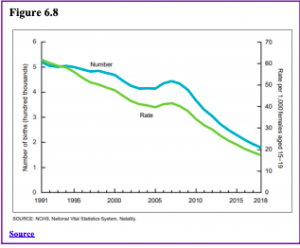
Consequences of Adolescent Pregnancy: After the child is born life can be difficult for a teenage mother. Only 40% of teenagers who have children before age 18 graduate from high school. Without a high school degree her job prospects are limited, and economic independence is difficult. Teen mothers are more likely to live in poverty, and more than 75% of all unmarried teen mother receive public assistance within 5 years of the birth of their first child. Approximately, 64% of children born to an unmarried teenage high-school dropout live in poverty. Further, a child born to a teenage mother is 50% more likely to repeat a grade in school and is more likely to perform poorly on standardized tests and drop out before finishing high school (March of Dimes, 2012).
Eating Disorders

Risk Factors for Eating Disorders: Because of the high mortality rate, researchers are looking into the etiology of the disorder and associated risk factors. Researchers are finding that eating disorders are caused by a complex interaction of genetic, biological, behavioral, psychological, and social factors (NIMH, 2016). Eating disorders appear to run in families, and researchers are working to identify DNA variations that are linked to the increased risk of developing eating disorders. Researchers from King’s College London (2019) found that the genetic basis of anorexia overlaps with both metabolic and body measurement traits. The genetic factors also influence physical activity, which may explain the high activity level of those with anorexia. Further, the genetic basis of anorexia overlaps with other psychiatric disorders. Researchers have also found differences in patterns of brain activity in women with eating disorders in comparison with healthy women.
Table 6.1
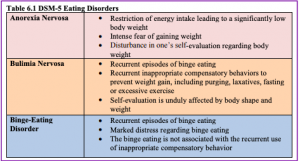
Health Consequences of Eating Disorders: For those suffering from anorexia, health consequences include an abnormally slow heart rate and low blood pressure, which increases the risk for heart failure. Additionally, there is a reduction in bone density (osteoporosis), muscle loss and weakness, severe dehydration, fainting, fatigue, and overall weakness. Anorexia nervosa has the highest mortality rate of any psychiatric disorder (Arcelus, Mitchell, Wales, & Nielsen, 2011). Individuals with this disorder may die from complications associated with starvation, while others die of suicide. In women, suicide is much more common in those with anorexia than with most other mental disorders.
Eating Disorders Treatment: To treat eating disorders, adequate nutrition and stopping inappropriate behaviors, such as purging, are the foundations of treatment. Treatment plans are tailored to individual needs and include medical care, nutritional counseling, medications (such as antidepressants), and individual, group, and/or family psychotherapy (NIMH, 2016). For example, the Maudsley Approach has parents of adolescents with anorexia nervosa be actively involved in their child’s treatment, such as assuming responsibility for feeding the child. To eliminate binge-eating and purging behaviors, cognitive behavioral therapy (CBT) assists sufferers by identifying distorted thinking patterns and changing inaccurate beliefs.

References
Albert, D., & Steinberg, L. (2011). Adolescent judgment and decision making. Journal of Research on Adolescence, 21, 211– 224.
American Psychiatric Association. (2013). Diagnostic and statistical manual of mental disorders (Fifth Edition). Washington, D. C.: Author.
Arcelus, J., Mitchell, A. J., Wales, J., & Nielsen, S. (2011). Mortality rates in patients with anorexia nervosa and other eating disorders. Archives of General Psychiatry, 68(7), 724-731.
Birkeland, M. S., Melkivik, O., Holsen, I., & Wold, B. (2012). Trajectories of global self-esteem during adolescence. Journal of Adolescence, 35, 43-54.
Bosson, J. K., Vandello, J., & Buckner, C. (2019). The psychology of sex and gender. Thousand Oaks, CA: Sage.
Brass, N., McKellar, North, E., & Ryan, A. (2019). Early adolescents’ adjustment at school: A fresh look at grade and gender differences. Journal of Early Adolescence, 39(5), 689-716.
Brown, B. B., & Larson, J. (2009). Peer relationships in adolescence. In R. M. Lerner & L. Steinberg (Eds.), Handbook of adolescent psychology (pp. 74–103). New York, NY: Wiley.
Carney, C., McGehee, D., Harland, K., Weiss, M., & Raby, M. (2015, March). Using naturalistic driving data to assess the prevalence of environmental factors and driver behaviors in teen driver crashes. AAA Foundation for Traffic Safety. Retrieved from www.aaafoundation.org/sites/...tionReport.pdf
Carroll, J. L. (2016). Sexuality now: Embracing diversity (5th ed.). Boston, MA: Cengage Learning.
Caspi, A., Lynam, D., Moffitt, T. E., & Silva, P. A. (1993). Unraveling girls’ delinquency: Biological, dispositional, and contextual contributions to adolescent misbehavior. Developmental Psychology, 29(1), 19-30.
Center for Disease Control. (2004). Trends in the prevalence of sexual behaviors, 1991-2003. Bethesda, MD: Author.
Center for Disease Control. (2016). Birth rates (live births) per 1,000 females aged 15–19 years, by race and Hispanic ethnicity, select years. Retrieved from www.cdc.gov/teenpregnancy/abo...-2011-text.htm
Centers for Disease Control. (2018a). Teen drivers: Get the facts. Retrieved from https://www.cdc.gov/motorvehiclesafe...factsheet.html
Centers for Disease Control. (2018b). Trends in the behaviors that contribute to unintentional injury: National Youth Risk Behavioral Survey. Retrieved from https://www.cdc.gov/healthyyouth/dat...trend_yrbs.pdf
Chein, J., Albert, D., O’Brien, L., Uckert, K., & Steinberg, L. (2011). Peers increase adolescent risk taking by enhancing activity in the brain’s reward circuitry. Developmental Science, 14(2), F1-F10. doi: 10.1111/j.1467-7687.2010.01035.x
Chen, B., Vansteenkiste, M., Beyers, W., Soensens, B., & Van Petegem, S. (2013). Autonomy in family decision making for Chinese adolescents: Disentangling the dual meaning of autonomy. Journal of Cross-Cultural Psychology, 44, 1184- 1209.
Connolly, J., Craig, W., Goldberg, A., & Pepler, D. (2004). Mixed-gender groups, dating, and romantic relationships in early adolescence. Journal of Research on Adolescence, 14, 185-207.
Connolly, J., Furman, W., & Konarski, R. (2000). The role of peers in the emergence of heterosexual romantic relationships in adolescence. Child Development, 71, 1395–1408.
Costigan, C. L., Cauce, A. M., & Etchinson, K. (2007). Changes in African American mother-daughter relationships during adolescence: Conflict, autonomy, and warmth. In B. J. R. Leadbeater & N. Way (Eds.), Urban girls revisited: Building strengths (pp. 177-201). New York NY: New York University Press.
Côtè, J. E. (2006). Emerging adulthood as an institutionalized moratorium: Risks and benefits to identity formation. In J. J. Arnett & J. T. Tanner (Eds.), Emerging adults in America: Coming of age in the 21st century, (pp. 85-116). Washington D.C.: American Psychological Association Press.
Crain, W. (2005). Theories of development concepts and applications (5th ed.). New Jersey: Pearson.
Crooks, K. L., & Baur, K. (2007). Our sexuality (10th ed.). Belmont, CA: Wadsworth.
Crosnoe, R., & Benner, A. D. (2015). Children at school. In M. H. Bornstein, T. Leventhal, & R. M. Lerner (Eds.). Handbook of child psychology and developmental science: Ecological settings and processes (pp. 268-304). Hoboken, NJ: John Wiley & Sons Inc.
De Wit, D. J., Karioja, K., Rye, B. J., & Shain, M. (2011). Perceptions of declining classmate and teacher support following the transition to high school: Potential correlates of increasing student mental health difficulties. Psychology in the Schools, 48, 556-572.
Dishion, T. J., & Tipsord, J. M. (2011). Peer contagion in child and adolescent social and emotional development. Annual Review of Psychology, 62, 189–214.
Dobbs, D. (2012). Beautiful brains. National Geographic, 220(4), 36. Dolgin, K. G. (2011). The adolescent: Development, relationships, and culture (13th ed.). Boston, MA: Pearson.
Duchesne, S., Larose, S., & Feng, B. (2019). Achievement goals and engagement with academic work in early high school: Does seeking help from teachers matter? Journal of Early Adolescence, 39(2), 222-252.
Dudovitz, R.N., Chung, P.J., Elliott, M.N., Davies, S.L., Tortolero, S,… Baumler, E. (2015). Relationship of age for grade and pubertal stage to early initiation of substance use. Preventing Chronic Disease, 12, 150234. doi:10.5888/pcd12.150234.
Eccles, J. S., & Rosner, R. W. (2015). School and community influences on human development. In M. H. Bornstein & M. E. Lamb (Eds.), Developmental science (7th ed.). NY: Psychology Press.
Elkind, D. (1967). Egocentrism in adolescence. Child Development, 38, 1025-1034.
Euling, S. Y., Herman-Giddens, M.E., Lee, P.A., Selevan, S. G., Juul, A., Sorensen, T. I., Dunkel, L., Himes, J.H., Teilmann, G., & Swan, S.H. (2008). Examination of US puberty-timing data from 1940 to 1994 for secular trends: panel findings. Pediatrics, 121, S172-91. doi: 10.1542/peds.2007-1813D.
Eveleth, P. & Tanner, J. (1990). Worldwide variation in human growth (2nd edition). New York: Cambridge University Press.
Furman, W., & Shaffer, L. (2003). The role of romantic relationships in adolescent development. In P. Florsheim (Ed.), Adolescent romantic relations and sexual behavior: Theory, research, and practical implications (pp. 3–22). Mahwah, NJ: Erlbaum.
Garcia, A. R., Metraux, S., Chen, C., Park, J., Culhane, D., & Furstenberg, F. (2018). Patterns of multisystem service use and school dropout among seventh-, eighth-, and ninth-grade students. Journal of Early Adolescence, 38(8), 1041-1073.
Giedd, J. N. (2015). The amazing teen brain. Scientific American, 312(6), 32-37. Goodman, G. (2006). Acne and acne scarring: The case for active and early intervention. Australia Family Physicians, 35, 503- 504.
Graber, J. A. (2013). Pubertal timing and the development of psychopathology in adolescence and beyond. Hormones and Behavior, 64, 262-289.
Grotevant, H. (1987). Toward a process model of identity formation. Journal of Adolescent Research, 2, 203-222
Harter, S. (2006). The self. In N. Eisenberg (Ed.), Handbook of child psychology: Vol. 3 Social, emotional, and personality development (6th ed., pp. 505-570). Hoboken, NJ: Wiley.
Harter, S. (2012). Emerging self-processes during childhood and adolescence. In M. R. Leary & J. P. Tangney, (Eds.), Handbook of self and identity (2nd ed., pp. 680-715). New York: Guilford.
Hihara, S., Umemura, T., & Sigimura, K. (2019). Considering the negatively formed identity: Relationships between negative identity and problematic psychosocial beliefs. Journal of Adolescence, 70, 24-32.
Hudson, J. I., Hiripi, E., Pope, H. G., & Kessler, R. C. (2007). The prevalence and correlates of eating disorders in the National Comorbidity Survey Replication. Biological Psychiatry, 61(3), 348-358.
Insurance Institute for Highway Safety. (2017). Fatality facts: Teenagers 2016. Retrieved from http://www.iihs.org/iihs/topics/t/te...nagersExternal
Kahneman, D. (2011). Thinking, fast and slow. New York NY: Farrar, Straus and Giroux.
Kim-Spoon, J., Longo, G.S., & McCullough, M.E. (2012). Parent-adolescent relationship quality as moderator for the influences of parents’ religiousness on adolescents’ religiousness and adjustment. Journal or Youth & Adolescence, 41 (12), 1576-1578.
King’s College London. (2019). Genetic study revelas metabolic origins of anorexia. Retrieved from www.sciencedaily.com/releases/2019/07/190715164655.htm
Klaczynski, P. (2001). Analytic and heuristic processing influences on adolescent reasoning and decision-making. Child Development, 72 (3), 844-861.
Klauer, S. G., Gun, F., Simons-Morton, B. G., Ouimet, M. C., Lee, S. E., & Dingus, T. A. (2014). Distracted driving a risk of road crashes among novice and experienced drivers. New England Journal of Medicine, 370, 54-59. doi: 10.1056/NEJMsa1204142
Kuhn, D. (2013). Reasoning. In. P.D. Zelazo (Ed.), The Oxford handbook of developmental psychology. (Vol. 1, pp. 744-764). New York NY: Oxford University Press.
Lee, J. C., & Staff, J. (2007). When work matters: The varying impact of work intensity on high school dropout. Sociology of Education, 80(2), 158–178.
Longest, K. C., & Shanahan, M. J. (2007). Adolescent work intensity and substance use: The mediational and moderational roles of parenting. Journal of Family and Marriage, 69(3), 703-720.
Luciano, M., & Collins, P. F. (2012). Incentive motivation, cognitive control, and the adolescent brain: Is it time for a paradigm shift. Child Development Perspectives, 6 (4), 394-399.
March of Dimes. (2012). Teenage pregnancy. Retrieved from http://www.marchofdimes.org/material...-pregnancy.pdf
Marcia, J. (2010). Life transitions and stress in the context of psychosocial development. In T.W. Miller (Ed.), Handbook of stressful transitions across the lifespan (Part 1, pp. 19-34). New York, NY: Springer Science & Business Media.
Marsh, H. W., & Kleitman, S. (2005). Consequences of employment during high school: Character building, subversion of academic goals, or a threshold? American Educational Research Journal, 42, 331–369.
McAdams, D. P. (2013). Self and Identity. In R. Biswas-Diener & E. Diener (Eds), Noba textbook series: Psychology. Champaign, IL: DEF publishers. Retrieved from: nobaproject.com.
McClintock, M. & Herdt, G. (1996). Rethinking puberty: The development of sexual attraction. Current Directions in Psychological Science, 5, 178-183.
Meeus, W., Branje, S., & Overbeek, G. J. (2004). Parents and partners in crime: A six-year longitudinal study on changes in supportive relationships and delinquency in adolescence and young adulthood. Journal of Child Psychology & Psychiatry, 45(7), 1288-1298. doi:10.1111/j.1469-7610.2004.00312.x
Mendle, J., Harden, K. P., Brooks-Gunn, J., & Graber, J. A. (2010). Development’s tortoise and hare: Pubertal timing, pubertal tempo, and depressive symptoms in boys and girls. Developmental Psychology, 46,1341–1353. doi:10.1037/a0020205
Mendle, J., Harden, K. P., Brooks-Gunn, J., & Graber, J. A. (2012). Peer relationships and depressive symptomatology in boys at puberty. Developmental Psychology, 48(2), 429–435. doi: 10.1037/a0026425
Miller, B. C., Benson, B., & Galbraith, K. A. (2001). Family relationships and adolescent pregnancy risk: A research synthesis. Developmental Review, 21(1), 1-38. doi:10.1006/drev.2000.0513
National Center for Health Statistics. (2014). Leading causes of death. Retrieved from: http://webappa.cdc.gov/sasweb/ncipc/...caus10_us.html
National Center for Statistics and Analysis. (2016, May). Young drivers: 2014 data. (Traffic Safety Facts. Report No. DOT HS 812 278). Washington, DC: National Highway Traffic Safety Administration. Retrieved from: wwwnrd.nhtsa.dot.gov/Pubs/812278.pdf
National Eating Disorders Association. (2016). Health consequences of eating disorders. Retrieved from https://www.nationaleatingdisorders....ting-disorders
National Institutes of Mental Health. (2016). Eating disorders. Retrieved from https://www.nimh.nih.gov/health/topi...rs/index.shtml
National Sleep Foundation. (2016). Teens and sleep. Retrieved from sleepfoundation.org/sleep topics/teens-and-sleep
Nelson, A., & Spears Brown, C. (2019). Too pretty for homework: Sexualized gender stereotypes predict academic attitudes for gener-typical early adolescent girls. Journal of Early Adolescence, 39(4), 603-617.
Office of Adolescent Health. (2018). A day in the life. Retrieved from www.hhs.gov/ash/oah/facts-an...ife/index.html
Pew Research Center. (2015). College-educated men taking their time becoming dads. Retrieved from http://www.pewresearch.org/fact-tank...becoming-dads/
Phinney, J. S. (1989). Stages of ethnic identity development in minority group adolescents. Journal of Early Adolescence, 9, 34- 49.
Phinney, J. S. (1990). Ethnic identity in adolescents and adults: Review of research. Psychological Bulletin, 108(3), 499-514. doi:10.1037/0033-2909.108.3.499
Phinney, J. S. (2006). Ethnic identity exploration. In J. J. Arnett & J. L. Tanner (Eds.) Emerging adults in America: Coming of age in the 21st Century. (pp. 117-134) Washington DC: American Psychological Association.
Rawatlal, N., Kliewer, W., & Pillay, B. J. (2015). Adolescent attachment, family functioning and depressive symptoms. South African Journal of Psychiatry, 21(3), 80-85. doi:10.7196/SAJP.8252
Rosenbaum, J. (2006). Reborn a virgin: Adolescents’ retracting of virginity pledges and sexual histories. American Journal of Public Health, 96(6), 1098-1103.
Ryan, A. M., Shim, S. S., & Makara, K. A. (2013). Changes in academic adjustment and relational self-worth across the transition to middle school. Journal of Youth and Adolescence, 42, 1372-1384.
Russell, S. T., Clarke, T. J., & Clary, J. (2009). Are teens “post-gay”? Contemporary adolescents’ sexual identity labels. Journal of Youth and Adolescence, 38, 884–890.
Sadker, M. (2004). Gender equity in the classroom: The unfinished agenda. In M. Kimmel (Ed.), The gendered society reader, 2nd edition. New York: Oxford University Press.
Schwartz, P. D., Maynard, A. M., & Uzelac, S. M. (2008). Adolescent egocentrism: A contemporary view. Adolescence, 43, 441- 447.
Seifert, K. (2012). Educational psychology. Retrieved from http://cnx.org/content/col11302/1.2
Shin, H., & Ryan, A. M. (2014). Early adolescent friendships and academic adjustment: Examining selection and influence processes with longitudinal social network analysis. Developmental Psychology, 50(11), 2462-2472.
Shomaker, L. B., & Furman, W. (2009). Parent-adolescent relationship qualities, internal working models, and attachment styles as predictors of adolescents’ interactions with friends. Journal or Social and Personal Relationships, 2, 579-603.
Sinclair, S., & Carlsson, R. (2013). What will I be when I grow up? The impact of gender identity threat on adolescents’ occupational preferences. Journal of Adolescence, 36(3), 465-474.
Smetana, J. G. (2011). Adolescents, families, and social development. Chichester, UK: Wiley-Blackwell. Soller, B. (2014). Caught in a bad romance: Adolescent romantic relationships and mental health. Journal of Health and Social Behavior, 55(1), 56-72.
Staff, J., Schulenberg, J. E., & Bachman, J. G. (2010). Adolescent work intensity, school performance, and academic engagement. Sociology of Education, 83, p. 183–200.
Staff, J., Van Eseltine, M., Woolnough, A., Silver, E., & Burrington, L. (2011). Adolescent work experiences and family formation behavior. Journal of Research on Adolescence, 22(1), 150-164. doi:10.1111/j.1532-7795.2011.00755.x
Steinberg, L., Icenogle, G., Shulman, E.P., et al. (2018). Around the world, adolescence is a time of heightened sensation seeking and immature self-regulation. Developmental Science, 21, e12532. https://doi.org/10.1111/desc.12532
Syed, M., & Azmitia, M. (2009). Longitudinal trajectories of ethnic identity during the college years. Journal of Research on Adolescence, 19, 601-624. doi:10.1111/j.1532-7795.2009.00609.x
Syed, M., & Juang, L. P. (2014). Ethnic identity, identity coherence, and psychological functioning: Testing basic assumptions of the developmental model. Cultural Diversity and Ethnic Minority Psychology, 20(2), 176-190. doi:10.1037/a0035330
Tartamella, L., Herscher, E., Woolston, C. (2004). Generation extra large: Rescuing our children from the obesity epidemic. New York: Basic Books.
Taylor, J. & Gilligan, C., & Sullivan, A. (1995). Between voice and silence: Women and girls, race and relationship. Cambridge, MA: Harvard University Press.
Thomas, R. M. (1979). Comparing theories of child development. Santa Barbara, CA: Wadsworth.
Troxel, W. M., Rodriquez, A., Seelam, R., Tucker, J. Shih, R., & D’Amico. (2019). Associations of longitudinal sleep trajectories with risky sexual behavior during late adolescence. Health Psychology. Retrieved from https://psycnet.apa.org/doiLanding?d...7%2Fhea0000753
Umana-Taylor, A. (2003). Ethnic identity and self-esteem. Examining the roles of social context. Journal of Adolescence, 27, 139-146.
United States Census. (2012). 2000-2010 Intercensal estimates. Retrieved from www.census.gov/popest/data/index.html
United States Department of Education. (2018). Trends in high school dropout and completion rates in the United States: 2018. Retrieved from https://nces.ed.gov/pubs2019/2019117.pdf
United States Department of Labor, Bureau of Labor Statistics (2016). Employment projections. Retrieved from http://www.bls.gov/emp/ep_chart_001.htm
United States Department of Labor, Office of Disability Employment Policy. (2019). School based prepatory experiences. Retrieved from: https://www.dol.gov/odep/categories/youth/school.htm
University of California at Los Angeles Medical Center. (2000). Acne. Retrieved from www.mednet.ucla.edu
Vaillancourt, M. C., Paiva, A. O., Véronneau, M., & Dishion, T. (2019). How do individual predispositions and family dynamics contribute to academic adjustment through the middle school years? The mediating role of friends’ characteristics. Journal of Early Adolescence, 39(4), 576-602.
Wade, T. D., Keski‐Rahkonen, A., & Hudson, J. I. (2011). Epidemiology of eating disorders. Textbook of Psychiatric Epidemiology, Third Edition, 343-360.
Weintraub, K. (2016). Young and sleep deprived. Monitor on Psychology, 47(2), 46-50. Weir, K. (2015). Marijuana and the developing brain. Monitor on Psychology, 46(10), 49-52.
Weir, K. (2016). The risks of earlier puberty. Monitor on Psychology, 47(3), 41-44.
Yau, J. C., & Reich, S. M. (2018). “It’s just a lot of work”: Adolescents’ self-presentation norms and practices on Facebook and Instagram. Journal of Research on Adolescence, 29(1), 196-209.
Attribution
Lifespan Development: A Psychological Perspective Second Edition by Martha Lally and Suzanne Valentine-French under the Creative Commons Attribution-Noncommercial-Share Alike 3.0 unported license.


